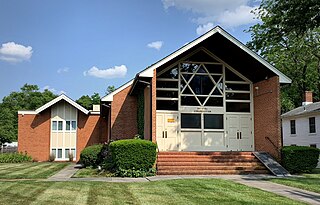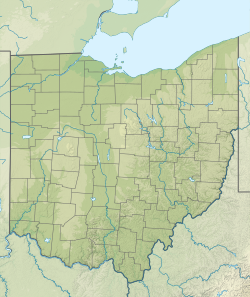
The Orthodox Union is one of the largest Orthodox Jewish organizations in the United States. Founded in 1898, the OU supports a network of synagogues, youth programs, Jewish and Religious Zionist advocacy programs, programs for the disabled, localized religious study programs, and international units with locations in Israel and formerly in Ukraine. The OU maintains a kosher certification service, whose circled-U hechsher symbol, U+24CAⓊCIRCLED LATIN CAPITAL LETTER U, is found on the labels of many kosher commercial and consumer food products.
The National Council of Young Israel (NCYI) or Young Israel, is a synagogue-based Orthodox Judaism organization in the United States with a network of affiliated "Young Israel" synagogues. Young Israel was founded in 1912, in its earliest form, by a group of 15 young Jews on the Lower East Side of Manhattan. Their goal was to make Orthodox Judaism more relevant to young Americanized Jews at a time when a significant Jewish education was rare, and most Orthodox institutions were Yiddish-speaking and oriented to an older, European Jewish demographic.
The history of Jews in Ohio dates back to 1817, when Joseph Jonas, a pioneer, came from England and made his home in Cincinnati. He drew after him a number of English Jews, who held Orthodox-style divine service for the first time in Ohio in 1819, and, as the community grew, organized themselves in 1824 into the first Jewish congregation of the Ohio Valley, the B'ne Israel. This English immigration was followed in the next two decades by the coming of German immigrants who, in contrast, were mostly Reform Jews. A Bavarian, Simson Thorman, settled in 1837 in Cleveland, then a considerable town, which thus became the second place in the state where Jews settled. Thorman was soon followed by countrymen of his, who in 1839 organized themselves into a congregation called the Israelitish Society. The same decade saw an influx of German Jews into Cincinnati, and these in 1841 founded the Bene Yeshurun congregation. To these two communities the Jewish history of Ohio was confined for the first half of the 19th century. In 1850 Ohio had six congregations: four in Cincinnati and two in Cleveland.

The Mount Sinai Jewish Center is a Modern Orthodox Jewish congregation and synagogue that practices in the Ashkenazi rite, located in the Washington Heights and Hudson Heights neighborhood of Manhattan in New York City, New York, United States.

Congregation Beth Israel Ner Tamid is an egalitarian Conservative synagogue located at 6880 North Green Bay Road in Glendale, a suburb north of Milwaukee, Wisconsin, in the United States.
Beth Israel Congregation is a Reform Jewish congregation and synagogue located at 5315 Old Canton Road in Jackson, Mississippi, in the United States. Organized in 1860 by Jews of German background, it is the only Jewish synagogue in Jackson. Beth Israel built the first synagogue in Mississippi in 1867, and, after it burned down, its 1874 replacement was at one time the oldest religious building in Jackson.

Congregation Beth Israel is an independent, traditional egalitarian Jewish congregation and synagogue, located at 229 Murdock Avenue in Asheville, North Carolina, in the United States. Founded in 1899 as Bikur Cholim, it was an Orthodox breakaway from Asheville's existing synagogue. It hired its first full-time rabbi in 1909, opened a religious school in 1911, and acquired its first building, which burnt down in 1916, in 1913.

Adas Israel is a Conservative synagogue in the Cleveland Park neighborhood of Washington, D.C., in the United States. It is the largest Conservative synagogue in the city.

Congregation Beth Israel is a Reform Jewish congregation and synagogue located at 5600 North Braeswood Boulevard, in Houston, Texas, in the United States. The congregation, founded in 1854, is the oldest Jewish congregation in Texas; and it operates the Shlenker School.
Congregation Beth Emeth is a Reform Jewish synagogue located at 100 Academy Road, in Albany, Albany County, New York, in the United States. Established in 1885, it is the fourth oldest Reform congregation in the United States.

Congregation Beth Jacob Ohev Sholom is an Orthodox Jewish synagogue located at 284 Rodney Street in Williamsburg, Brooklyn, in New York City, New York, United States. The congregation follows the Ashkenazi rite.

Anshei Sphard Beth El Emeth Congregation, abbreviated as ASBEE, was an Modern Orthodox synagogue located at 120 North East Yates Road, in East Memphis, Tennessee, in the United States. Established in 1966, with a history dating from 1861, the congregation operated for over 160 years prior to its 2023 merger with the Baron Hirsch Congregation.
Anshe Emet Synagogue is a Conservative Jewish congregation and synagogue, located at 3751 North Broadway, in the Lake View neighborhood of Chicago, Illinois, in the United States. Established in 1873, it is one of the oldest congregations in Chicago.

The Jewish community of the Greater Cleveland area comprises a significant ethnoreligious population of the U.S. State of Ohio. It began in 1839 by immigrants from Bavaria and its size has significantly grown in the decades since then. In the early 21st century, Ohio's census data reported over 150,000 Jews, with the Cleveland area being home to more than 50% of this population. As of 2018, Greater Cleveland is the 23rd largest Jewish community in the United States. As of 2023, the Cleveland Jewish Community is estimated to be about 100,000 people.

Historic Congregation B’nai Abraham, officially B’nai Abraham Chabad, is an Orthodox Jewish congregation and synagogue, located at 523-527 Lombard Street, in the Society Hill neighborhood of the Center City of Philadelphia, Pennsylvania, in the United States. Established as a congregation in 1874 and the current synagogue building completed in 1910, worshipers can access daily, Shabbat, and holy day services in the Ashkenazi rite. B'nai Abraham is home to a Jewish Preschool, as well as Lubavitch of Center City.
Solomon Goldman was an American Conservative rabbi. A noted orator, community leader and scholar, he was especially known for helping to popularize the cause of Zionism in the United States.
Black Jews in New York City comprise one of the largest communities of Black Jews in the United States. Black Jews have lived in New York City since colonial times, with organized Black-Jewish and Black Hebrew Israelite communities emerging during the early 20th century. Black Jewish and Black Hebrew Israelite communities have historically been centered in Harlem, Brooklyn, The Bronx, and Queens. The Commandment Keepers movement originated in Harlem, while the Black Orthodox Jewish community is centered in Brooklyn. New York City is home to four historically Black synagogues with roots in the Black Hebrew Israelite community. A small Beta Israel (Ethiopian-Jewish) community also exists in New York City, many of whom emigrated from Israel. Black Hebrew Israelites are not considered Jewish by the New York Board of Rabbis, an organization representing mainstream Rabbinic Judaism. However, some Black Hebrew Israelite individuals in New York City are recognized as Jewish due to converting through the Orthodox, Conservative, or other Jewish movements.
The history of Jews in Milwaukee began in the early 1840s with the arrival of Jewish immigrants from German-speaking states and the Austro-Hungarian empire. Throughout the 19th century, Milwaukee was the hub of Wisconsin's Jewish population with 80% of the state's Jews living there. As of 2011, it is home to 25,800 Jewish people, or 78% of Jews in Wisconsin, and is the 42nd largest Jewish community in the United States.

Beth El Congregation is a Reform Judaism congregation located at 520 Fairmont Avenue in Winchester, Virginia, in the United States. The local Jewish community developed in the late-19th century. They were mostly merchants who observed dietary laws (kosher), often having to travel to Baltimore for supplies. In 1908, the Jewish citizens decided to observe its first High Holy Days. Two local leaders learned shochet laws, enabling local Jews to keep kosher without having to travel out of town.












